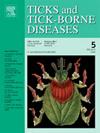匈牙利最近可能出现的rufipes透明瘤的评估
IF 3.4
2区 医学
Q2 INFECTIOUS DISEASES
引用次数: 0
摘要
这项研究的目的是评估一个机会主义的rufipes种群的生存能力,因为有证据表明,在中欧南部,特别是匈牙利,在2022年有繁殖的证据。为了评估目前的情况,在2022年9月至2024年5月期间,在当地兽医的协助下,组织了针对各种哺乳动物物种的蜱虫收集。在研究期间,收集了1502只蜱虫;然而,没有一个属于透明藻属。在我们的样本种群中,网状革螨占主导地位(n = 963),其次是蓖麻伊蚊(n = 436)。在该地区发现的其他物种有:相邻血蜱(45种)、边缘革蜱(38种)、六角形伊蚊(13种)、小异角蜱(6种)和血头蜱(1种)。在2022年至2024年期间,从兽医那里收到了两只边缘透明瘤雄性,尽管这些动物远离我们的研究区域。我们的研究结果表明,2022年记录的H. rufipes种群并没有持续存在。本文章由计算机程序翻译,如有差异,请以英文原文为准。
An assessment of the possible recent establishment of Hyalomma rufipes in Hungary
The aim of this study was to assess the viability of an opportunistic population of Hyalomma rufipes, as evidence of reproduction had been documented in the southern part of Central Europe, specifically Hungary, in 2022. To assess the current situation, tick collections targeting various mammalian species were organized with the assistance of local veterinarians between September 2022 and May 2024. Over the study period, 1502 ticks were collected; however, none belonged to the Hyalomma genus. Dermacentor reticulatus dominated in our sample population (n = 963), followed by Ixodes ricinus (n = 436). Other species found in the area were: Haemaphysalis concinna (n = 45), Dermacentor marginatus (n = 38), Ixodes hexagonus (n = 13), Alloceraea inermis (n = 6), and Rhipicephalus sanguineus s.s. (n = 1). Two Hyalomma marginatum males were received from veterinarians between 2022 and 2024, although these were collected far from our study area. Our results suggests that the H. rufipes population recorded in 2022 did not persist.
求助全文
通过发布文献求助,成功后即可免费获取论文全文。
去求助
来源期刊

Ticks and Tick-borne Diseases
INFECTIOUS DISEASES-MICROBIOLOGY
CiteScore
6.90
自引率
12.50%
发文量
185
审稿时长
6-12 weeks
期刊介绍:
Ticks and Tick-borne Diseases is an international, peer-reviewed scientific journal. It publishes original research papers, short communications, state-of-the-art mini-reviews, letters to the editor, clinical-case studies, announcements of pertinent international meetings, and editorials.
The journal covers a broad spectrum and brings together various disciplines, for example, zoology, microbiology, molecular biology, genetics, mathematical modelling, veterinary and human medicine. Multidisciplinary approaches and the use of conventional and novel methods/methodologies (in the field and in the laboratory) are crucial for deeper understanding of the natural processes and human behaviour/activities that result in human or animal diseases and in economic effects of ticks and tick-borne pathogens. Such understanding is essential for management of tick populations and tick-borne diseases in an effective and environmentally acceptable manner.
 求助内容:
求助内容: 应助结果提醒方式:
应助结果提醒方式:


